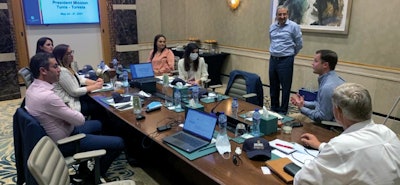
Despite restrictions that COVID-19 has placed on the world trading market, the U.S. Grains Council (USGC) has continued building grain sales. Expanding activities in the Middle East has been a particular focus of its efforts.
The Middle East has continued to increase its imports of U.S. grains over the last few years. Saudi Arabia ranks as the eighth-largest destination for U.S. corn in the 2019/2020 marketing year, importing nearly 909,000 metric tons. Israel has more than doubled its U.S. corn imports to almost 490,000 metric tons. and has increased its purchase of U.S. barley to more than 1,100 metric tons. Purchases of U.S. distiller’s dried grains with solubles (DDGS) have continued to expand, with Turkey being the sixth-largest market at 602,000 metric tons.
The USGC continues to offer trade servicing and virtual grains education programming during the pandemic to maintain and increase those purchases.
Virtual training
Some online activities include conducting educational training in the region, as evidenced by a short course offered on poultry and feed management to participants from Saudi Arabia, Oman and Jordan. The program brought together 35 participants with U.S. corn and co-products, its uses and nutritional value when used within poultry rations.
The program covered all aspects of poultry and feed manufacturing, including an overview of U.S. grain grading and standards, feed ingredient handling and storage and poultry management in hot climates, among other topics. The program featured leading poultry and feed industry experts from Iowa State University, Auburn University, the University of Arkansas and the National Agronomic Institute in Tunisia (INAT).
The USGC conducted the training on its newly created e-platform for its Center for Feed Manufacturing, based in Tunis, Tunisia. It combined individual learning modules and course material with seminars conducted live with program instructors to allow discussion and questions. Technical, hands-on exercises were conducted in the center’s state-of-the-art feed mill and refurbished laboratory, facilitated by local trainers who have previously attended feed manufacturing training both under the USGC’s recently completed U.S. Department of State-funded feed manufacturing training program.
While virtual, the program allows for as much interaction as possible between instructors and participants, with successful participants receiving a program certificate following all course sessions.
Trade servicing in Egypt
In addition to offering educational opportunities in the region, the USGC conducts trade servicing, often working with other U.S. organizations to help feed grains companies improve their production efficiencies.
Recently, Kyle Gilliam, USGC manager of global strategies and trade, worked with Dr. Vijay Singh, a high-level starch consultant at the University of Illinois in Egypt, to help a Cairo-based industrial starch company be more efficient with its inputs and increase profitability.
Dr. Singh’s consultation began in 2019 as he helped the starch producers evaluate their facilities and identify processes that could improve their overall operations.
The USGC’s recent industrial corn starch study was shared with the starch company. The findings showed that U.S. corn could extract 3% to 4% higher yields of starch versus corn of other origins, which can significantly impact the plant’s overall profitability.
While in Cairo, Dr. Singh and Gilliam helped the Egyptian starch company understand the technology and science associated with corn wet milling through an audit. The study’s results show processing 1,500 tons/day of corn can gain about $1 million/year in additional profit for every 1% increase in starch yield. But to reach these higher yields, a plant must optimize its operations.
Increasing the use of starch by Egyptian customers could mean additional sales of U.S. corn — both for starch and other purposes.
U.S. corn exports to North Africa and the Middle East are highly variable and compete on price with South American and the Black Sea corn. The region has more than 2 million metric ton (MMT) annual demand, however, for corn by 15 industrial starch plants.
Suppose the USGC’s engagement with the starch sector is successful. In that case, the USGC will establish a consistent demand for 2 MMT of U.S. corn in the region for the industrial starch sector. In turn, this could increase overall demand for U.S. corn on an annual basis as traders and vessels are routinely shipping U.S. corn into the region 12 months of the year rather than just six. Subsequently, the local starch industry has the potential to earn a combined $15 million more annually due to higher starch yields in U.S. corn.
DDGS production, nutrition courses in Saudi Arabia
Driven by the high demand for protein, the feed market in Saudi Arabia has increased imports of DDGS supplied from the U.S. from 13,000 metric tons (MT) imported in both 2018 and 2019 to 24, 000 MT in 2020, signaling a growing market for DDGS.
Because of this, the program incorporated sessions focused on DDGS production uses and nutritional value for participants.
Through the programs, the USGC aims to explain the benefits of DDGS use in the Saudi feed industry by addressing market constraints that limit expansion in the industry.
The USGC’s recent efforts are focused on ensuring feed mills and producers are using appropriate feed ratios to secure market opportunities for DDGS.
The poultry feed training program engaged feed mill operations and livestock producers in the Saudi poultry sectors in extensive training programs to improve overall feed manufacturing. The program helps modernize Saudi Arabia’s feed and livestock industries.
As a result of the USGC’s educational efforts, the feed industry in Saudi Arabia purchased 15,000 MT in the marketing year 2020/2021 (through March 2021), 144% growth compared to the same period in the previous marketing year.
In-person travel resumes
In late May, the USGC’s Middle East and Africa regional office in Tunis, Tunisia, was host to one of the organization’s first overseas missions since pandemic restrictions began. USGC Chairman Jim Raben, President and CEO Ryan LeGrand and Senior Director of Global Strategies Kurt Shultz met with staff and visited the feed training center the USGC helped establish to serve the region.
The feed training center has already trained more than 200 feed professionals from all parts of the continent to learn about the latest production techniques and advances in animal nutrition.
It illustrates the USGC’s greater work to build relationships and foster a better understanding of U.S. grain products and the value chain it employs to move grain worldwide.
During their time in Tunisia, the group met with some of the leading poultry and feed manufacturing companies in the country and saw a shipment of U.S. DDGS at a local feed mill. The USGC promotes both bulk and container shipments in the region.
The group also met with the USGC’s regional staff in the Middle East and Africa office in Tunis to discuss USGC’s marketing strategies in the region.
Keeping demand up
The pandemic has challenged the USGC to continue its work in new ways to keep grain flowing worldwide.
While the USGC reached key markets and a greater number of participants by organizing virtual training programs during the pandemic, the members of the mission to Tunisia were glad to finally visit in person once again and connect directly with key stakeholders.
The training conducted in the Middle East — whether in-person or online — promises to help feed production in the region become more efficient and widespread, stimulating demand and leading to continued U.S. agricultural imports.
Learn more about the USGC’s work in the Middle East and Africa. ■

















